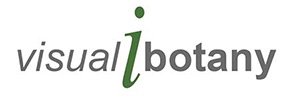3. Mixed media in the botanical illustrations
Since many of my illustrations are composite images, they lend themselves to mixed media work, where parts created in different media can be combined together within the final image. But not mixed media in the traditional botanical artists’ sense of, for example, pen and watercolour, but digital mixed media. By this I mean any combination of digital media, such as flatbed scans, digital photographs, scanned conventional printed photographs and digitised slides (both black and white or colour), scanning electron micrographs, digital sketches, digital line drawings, digital diagrams, as well as scanned hand drawn artwork.
As my earliest illustrations were all created from photographs taken before I had a digital camera, most of the parts within those illustrations, (such as the mistletoe) were created from photographic slides scanned on a home scanner. Also in the early days, as a beginner photographer, I was sometimes unable to get a satisfactory photograph of a part and so I tried out using a digitally drawn diagrammatic parts instead. This worked fine, but turned out to be temporary measures, since I was able to replace them the following year with a photographic parts, which clearly showed far more.
Central portion of my composite illustration of mistletoe,
compiled using mixed media
© Niki Simpson 2015
To see examples of what I mean by digital mixed media, take a look at my illustration of mistletoe, Viscum album above, where I have used a black and white line sketch drawing to show the habit (part A). For another example, see my illustration of the cuckoo pint, Arum maculatum, in my gallery, in which the habit (part R) is also shown as a line sketch, this time in sepia, not black.
Lower portion of my composite illustration of mistletoe,
including a SEM of pollen
© Niki Simpson 2015
Pollen grains part J: © PALDAT – with written permission
A different example of mixed media within an illustration, can also be seen in the mistletoe illustration, where I included a scanning electron micrograph to depict the pollen grains (part J). These micrographs are by default black and white, but while lacking colour information, still provide additional descriptive information of the taxon. Please note that I did not take this SEM myself – I was kindly given permission from PalDat in 2007 to use one of their images and to isolate the pollen grains from the original background, in order to be able to trial the use of a pollen SEM within this type of digital composite botanical illustration. The resulting composite image was included in my exhibition entitled Digital Diversity at the BGBM in Berlin that year.
Flatbed scans can be good for flat, very 2-dimensional plant parts, such as leaves, but I now rarely use these, as I find it is difficult to get the lighting to look consistent with the other photographed parts within the final illustration, where I am better able to control the direction of the lighting and to minimise the shadows the plant throws, both on itself and on to the background.
But, while my composite images can be mixed media, you will see in looking through the illustrations in the galleries, that for most illustrations I have only used photographic parts. This is because my first choice is nearly always for a photographic part (that is where I am able to achieve a photo which shows the information I want it to) – and this is for important reasons. A photographic part is, when simply isolated from its background and not manipulated, surely as close to the ‘botanical truth’ as one is going to get in a 2D representation – full realism, yes, but importantly, further realism and detail as well, since hidden descriptive details can be revealed on enlargement, literally at the touch of a button. (See my previous post below Part 2. Enlarging hidden details). Unlike photographic parts, a line drawing, whether digital or hand drawn, on the other hand reveals nothing further on enlargement. The ability to considerably enlarge my images to reveal further features is an aspect not apparent to those simply seeing this type of image either as paper prints or as small, low res images on a webpage.


